|
Eugenio,77
mail@toyota-club.net
© Toyota-Club.Net
Dec 2019 - Mar 2022
The article is being supplemented as practical experience is gained and new common faults and features of the model are identified. It prioritizes the local market vehicles, which have a number of configuration and option differences.
VEHICLE
5th generation Toyota RAV4, model #XA5#, production launched since 11.2018 - for the European and American markets, since 04.2019 - for the Japanese market, since 09.2019 - for local market.
Our mandatory requirements for a crossover / SUV - automatic transmission, air conditioning, all-wheel drive - have been unchanged for decades, so the "basic version" hereinafter does not mean the first line of the price list.
TECHNOLOGY:
platform ·
engine ·
CVT ·
8AT ·
4WD DTC ·
4WD DTV ·
suspension ·
brakes ·
steering
TECHNOLOGY:
body ·
luggage ·
meter ·
climate ·
SRS ·
ADAS ·
multimedia ·
options
STATIC VIEW:
exterior ·
interior ·
seat, ergonomics, visibility ·
passenger ·
rear seat
TEST-DRIVE:
acceleration ·
braking ·
steering ·
ride comfort ·
off-road ·
noise
SUMMARY
PLATFORM
Four out of five journalists use the phrase "built on the TNGA platform", but it's good if one out of five distinguishes between "platform" and "architecture", and one out of ten can remember at least one of previous Toyota platform names. These words even less meaning for a reader who is far from the history of automotive industry. Moreover, everything could be simply stated in one paragraph:
·In Toyota practice, the concept of "platform" means a common set of power units and the same layout on models of a comparable size and class;
·TNGA - toyota new global architecture - means the entire set of new platforms;
·Where "New" emphasizes the difference between this architecture (presented in 2015) from previous platforms that smoothly evolved from the early-2000s;
·The RAV4 XA50 is built on the TNGA-K platform and a noteworthy point here is that all previous generations were built on the basis of the D-class (Corona, MC, New MC), while the current one shares the platform with Camry, Highlander etc.
ENGINE

| Engine |
Displacement, cm3 |
Bore x Stroke, mm |
Compression ratio |
Power, PS |
Torque, Nm |
System |
| M20A-FKS | 1987 | 80.5 x 97.6 | 13.0 | 149 (171) / 6600 | 206 / 4400-4900 | D-4S |
| A25A-FKS | 2487 | 87.5 x 103.4 | 13.0 | 199 (205) / 6600 | 243 / 4000-5000 | D-4S |
The most detailed description - in our large review "Toyota engines - Dynamic Force (R4)"
Worldwide operating experienc of 2.5 is counted from the end of 2017, 2.0 appeared in 2018, so we will not evaluate their durability in advance, and as for reliability, critical mass defects have not appeared until now.
Operating experience of 2.5 is counted since the end of 2017, 2.0 appeared in 2018,
so we will not evaluate their durability in advance, and as for reliability, critical mass defects have not appeared until now.
It is noticeable that many people are confused by the combination of the compression ratio and the recommended fuel octane number, so we recall once again:
· For modern engines with a Miller cycle, the nominal geometric compression ratio is not related to the real one (the figure from the specs is more correctly called the "expansion ratio");
· Direct injection also radically changes the mixture formation and ignition process in cylinders (reducing the knocking possibility);
· At branded gas stations, the real octane rating has not been a problem for a long time.
Therefore, it is time to sprinkle the ancient rule "compression ratio up to 10 - RON 92, more than 10 - 95, more than 11 - 98" with mothballs and put away into the far corner of the garage.
Upd. Overseas users were warned that the A25A could leak coolant from the electric pump and/or the associated DTC fault codes P26CB71, P26CA14, P26CA31 could appear. Problem status - under investigation.
TRANSMISSION - CVT

K120F is the first fundamental innovation in the Aisin/Toyota CVT family in twenty years. Learn more about the new design versus the previous one - "Toyota Direct Shift-CVT"
Just like the engine, the CVT starts its history blank. On the one hand, a significant increase in the number of actuating and control elements and bearings is not beneficial, on the other hand, the operating conditions of the variator part itself and the belt have become lighter.
K120F. 1 - input shaft, 2 - planetary gear, 3 - B1 brake, 4 - C1 clutch, 5 - primary pulley, 6 - secondary pulley, 7 - C2 clutch, 8 - drive gear 1, 9 - driven gear 1, 10 - synchronizer, 11 - drive gear 2, 12 - driven gear 2, 13 - reduction drive gear, 14 - reduction driven gear, 15 - pinion gear, 16 - differential gear
|
TRANSMISSION - 8AT

UB80F made its debut on the RAV4 only formally - the family of Aisin 8-speed has been installed on Toyota and other brands since the mid-2010s. On the mechanical and hydraulic side, everything looks even better than expected, but as for the control software...
Since the beginning of the 2000s, each new generation of automatic transmissions receives raw firmware of control units, which gradually improve and become adequate at best by the time of the first restyling. If during this time the bad algorithms destructed the hardware, then under warranty the AT is changed (at least in the American market). The fact that history is repeating once again could be predicted by the behavior of the UA80#'s (see T-SB-0160-18), and soon the American owners of RAV4 began to massively criticize the work of the new 8AT at low speeds. The reprogram campaign began only in the fall of 2019 (see T-SB-0107-19) and, judging by the feedback from the owners, it is too early to talk about full healing.
Upd. NHTSA was notified that there were leaks at the joint of the 'side cover'. Problem status - under investigation.
AWD - DTC

Detailed description - "Toyota all-wheel drive. ATC/DTC"
Twenty years of using this 4WD type on Toyota allowed to thoroughly study its capabilities and reliability. One standard defect is wear of the coupling bearings (mainly the front), and if replacement process is wrong, damage to the wiring of the electromagnet is sometimes added here.
It is worth noting that when creating the RAV4 50, Toyota for the first time was concerned about the efficiency of DTC (even more than poor early) - and, as practice shows, they have quite succeeded in this.
AWD - DTV

Detailed description - "Toyota all-wheel drive. DTV AWD"
Almost all reviewers mention two rear wheel drive couplings, but few pay attention to the real innovation - disconnecting clutches in the rear reductor and transfer case.
 But exactly this clutch have become a source of problems: abnormal sound of the clutch in transfer ("mooing") brings the owners to distraction (for leisurely driving in city traffic the "moo" groan could be heard almost every minute). The replacement of the cam clutch electromagnet practiced by the Toyota seems a palliative treatment. But exactly this clutch have become a source of problems: abnormal sound of the clutch in transfer ("mooing") brings the owners to distraction (for leisurely driving in city traffic the "moo" groan could be heard almost every minute). The replacement of the cam clutch electromagnet practiced by the Toyota seems a palliative treatment.
Upd. Again, something is wrong with AWD - to eliminate the "triple knock during deceleration" or "stick slip noise", it is prescribed to replace the rear differential assembly (41110-42052 → 41110-42080 / 41110-42053, TSB CP-00381T-TME for cars built pre-May'20).
Upd. It is worth paying attention to TSB CP-00636T-TME dated 11/10/2021 related with transfer and DTC C13F700.
The 2-couplings scheme itself is progressive and promising, but the addition of extra cam clutches for disconnecting the propeller shaft has become a real engineering sabotage. Apparently, Toyota understand the problem - having tested DTV on RAV4 and Highlander, they left the new generation of Lexus NX with a proven DTC.
SUSPENSION

Fundamentally and visually, the design remains the same - McPherson at front and multi-link at rear. Nevertheless, non-obvious changes (a complicated subframe, a repositioned arms mounting points, a vertical rear shock absorber with a new set of valves, silentblocks instead of ball-joints...) gave a definite positive effect.
Toyota believes that R18 and R19 wheels are more attractive for aboriginals than regular R17, although only tyre manufacturers and tyre workshops benefit from this. Meanwhile, the Americans, on the contrary, use high-profile R16 with an all-terrain tread.
Upd. Toyota has to report about safety recall of RAV4 vehicles produced in autumn of 2019 due to a defect of the front suspension lower arms: cracks may appear and propagate which may cause destruction of the arm and separation from the wheel (mainly if frequently operated with intense accelerations and decelerations). Prescription - replacement of the lower arms. Japanese internal recall #4748, active since 21 may 2020.
Corresponding instructions passed across all regions where Japanese-made RAV4 sold. USA - NHTSA campaign 20V286000 (Toyota # 20TA08 / 20TB08), Europe - campaign 20SMD-006.
BRAKES

Compliance with the requirements of the time is normal: ABS + EBD + BA + TRC + VSC + HSA + DAC + EPB.
The only pity is that cars for the emergency market receive simple 1-piston calipers, while improved 2-piston calipers are supplied to the European market.
|
Upd. TSB CP-00665T-TME (08.12.2021) prescribed brake actuator calibration update
in case of DTC C059746 and C14FE14 appearing (EPB system malfunction).
|
STEERING

One of the innovations of the TNGA-K platform - the power steering motor has moved from the column to the steering rack. It may be worse for the motor itself, now exposed to the environment, but it is much better for steering feel and for the durability of the joints, splines and gears of the entire steering mechanism (which Toyota could not boast since the first introduction of the EPS).
1 - steering rack, 2 - torque sensor, 3 - control unit and electric motor
|
Upd. A minor defect of EPS was awarded with TSB - the appearance of a DTC C05D604 is possible, it is solved by reprogramming of the EPS ECU.
Upd. The second noted feature is that the EPS zero point calibration fails not only after disconnecting or discharging the battery, but sometimes just after a cold soak, as a result of which the car "pulls" while driving.
BODY

In the theme of body rigidity Toyota reported a "57% increase over the previous generation". The public heard them, checked, and poured out a doubly deserved bucket of slops.
Plastic shields designed to improve aerodynamics and reduce noise can be found on different Toyota cars since the beginning of the 2010s, but in ru-conditions thanks to them a little less salty mud gets to the metall covered only with a light layer of the primer. Well, for once, Toyota made the underbody without protruding exhaust elements.
Aluminum body parts are used on the US-market for a few years, what the aluminum hood, tailgate, front fenders and bumper beam will give to customers - only time will tell. The hood is traditionally supported by a stick, this time particularly uncomfortable. (Rem. Less than $20 for a pair of air struts with mounts at ali)
The doorsills are covered with door linings, but the number of their seals has not turned into quality, so you will have to work on the tightness yourself. The transformation of the door edge into an integral part of the wheel arch was clearly not invented in a country where the year is divided into a season of road reagents and a season of road dust. The opening angle of both the front and rear doors is poor.
US-owners have already passed advices to check the welding of door frames, the plastic fenders free-play, the roof railing mounts tightness.
According to diy-reports, everyone can assess the quality of what factory noise insulation should be named... it works the same as it looks.
And one more recommendation: check the windshield for distortions, mainly along the lower boundary of the central part.
What about the paintwork quality, everything is sad - "the car is two months old, but it looks like I drove intercity for years", "I do not know what kind of varnish it is, but bird droppings remain matte spots immediately"... The only suggested option is to use a protective film (at least for metal parts of the frontal projection).
Upd. "Side mirrors dangle at speed like spaniel ears" - as the owners themselves note. But so far they only state it here, in USA already achieved a warranty repair of this problem - with new enforcer, elongated studs and a dose of sealant (TSB-0079-20).
LUGGAGE AREA

Large volume and primitive organization: a set of 4 wheels fits, an unpainted bumper does not need protection, there are only loops for the straps, a curtain without a handle, no buttons for remote reclining the rear seat back.
The flooring is durable, double-sided (plastic/pile), with two possible installation levels. But in any case a rubber cover is preffered here.
A narrow spare wheel is stored in the underfloor, but a full-sized wheel can be placed (225 width - ideally, 235 - almost) - of course, at the cost of losing the two-level floor and the ability to remove the curtain under it.
The electric tailgate even in the basic version is not a gift from the Japanese, but about $1265 in the price of each car.
Upd. A lot of complaints about the luggage floor failure even with a relatively light load had an effect: Toyota released TSB BO-00440T-TME "Deck board broken and deck side trim deformed by loading in luggage area", where they prescribe a warranty replacement of the side panel in case of its deformation (with the modified one, and it is allowed to replace at only one side). In the meantime, the owners themselves are fighting the problem, either placing wooden blocks, or even make wooden gratings so that the floor deck rests directly on the spare wheel.
METER

The basic version is a very primitive analogue one with a 4 "display (the only good thing is the digital speedometer mode and the torque and wheel rotation diagram).
Initially, the meter looked normal (except the lower gauges and circular digits):
... but the order to redesign the speedometer "for Europe" took the designer by surprise and he draw mismatched graduation (correlate the figures and dashes at 120-180):
The top versions have a semi-analog meter with a 7" display... which was outdated even before the release, and readability on the go was not included in the terms of reference at all.
CLIMATE

It's hard to find a fault - dual-zone climate control, central deflectors could be closed, a deflector for the rear seat. Already basic version has heated side segments of the steering wheel, windshield, washer nozzles, not to mention the front seats and mirrors (in total, such Cold package cost about $ 900, but seems worth it).
SRS

Standard modern equipment - two front airbags, two side airbags, two curtains plus a driver knee airbag. EuroNCAP score - 5 stars and good points in different disciplines. But it should be noted that all prizes and stars are given for world market versions and take into account the presence of a complete set of driver assistance systems, while...
ACTIVE SAFETY. ADAS

To explain the essence of... difficult to say... inadmissible behavior of local Toyota department we need a separate article - "RAV4. Safety not for all"
 Briefly - at all civilized markets TSS 2.0 is part of standard equipment for any grade but local Toyota left it for the top versions only. Briefly - at all civilized markets TSS 2.0 is part of standard equipment for any grade but local Toyota left it for the top versions only.
MULTIMEDIA
 / / 
The most accurate and comprehensive description is in the screenshot from the Polish review:
The Japanese entered their domestic market more elegantly, offering by default a plastic plug and freedom of choice of the main device - from a radio for $300 to a 10" TV for $2500.
In US, the basic version also has a terrible-looking 6" device, but its functionality is the same as of local version and the price is about $1000 cheaper.
After all, the problem is not even in the poor functionality, primitive graphics and shameful performance speed - but in the fact that for its pseudo-multimedia Toyota adds a very real 4-digit amount to the price of the car.
ELECTRICS. OPTIONS

By the third decade of the XXI century, the Japanese car finally became standard equipment: LED headlights and rear lights, all power windows with auto mode, TPMS (but without pressure indication), factory alarm system with movement sensor, rain sensor, rear parking sensors, folding mirrors, dynamic lines of the rear view camera, keyless access and start.
The Japanese logic somewhere is strange: the illumination is most needed for the buttons of the central lock and folding mirrors? - so they installed a single diode in the driver's power window button; it is convenient to turn on the map lamp by pressing the lamp lens? - they made a separate not-illuminated small button...
Rem. People themselves replace it with illuminated button modules for windows (Camry, C-HR, Corolla etc. 84040-33170/06070/10020) and mirrors (Crown 84872-30070). Duplicates from ali are cheaper, but raise quality issues.
"Why is the interior light not diode?" - Toyota offers an option for $370 (Rem. People just changing bulbs to LEDs in the same cases for about $10)
"Why is the armrest unmovable?" - Toyota offers an option for $120
"Why are the fog lights simple halogen?" - Toyota offers an option for $450, with switchable two-color LED fog lights. (Rem. The people solve the issue for $100-150, installing either LEDs modules, or the original diode fog lights entirely)
VARIANTS
· Toyota RAV4 - basic model in 3 versions: hybrid with A25A-FXS (deforced to 177 PS), front electric motor 3NM (120 PS) and rear motor 4NM (54 PS), with Ni-Mh battery; pure gasoline with M20A-FKS (2.0 CVT 175 PS) and A25A-FKS (2.5 8AT 205 PS).
· Toyota Wildlander - restyled version for chinese market.
· Mitsuoka Buddy - old-timer-style version.
· Toyota RAV4 PHV / PHEV / Prime - plug-in hybrid with large Li-ion battery and front motor 5NM (180 PS), for JAP/EUR/USA markets.
· Suzuki Across - slightly restyled PHEV version for Europe.
· Toyota Harrier - closely related model, in fact a cross-coupe based on the standard RAV4 (2.0 CVT and 2.5 HV)
· Toyota Venza - only hybrid version of Harrier for US market.
· Lexus NX - closely related 'premium' model: in addition to hybrid (A25A-FXS + 3NM/4NM), PHEV (A25A-FXS + 5NM/4NM) and gasoline A25A-FKS, turbo was added T24A-FTS (2.4 8AT 278 PS) with slightly modified DTC 4WD.
EXTERIOR

The XA50 literally destroyed its predecessor at the New York premiere on the morning of March 28, 2018. In the autumn of 2019 local Toyota dealers finished it off by itself - established advertising campaign on the strong opposition of the new generation and "the old rav".
In general, the exterior is relevant, adequate, moderately brutal, somewhat echoes the real Toyota SUVs of the American market. It looks best on renderings, for photos and videos it needs the right angles, in life it seems easier, more compact and rougher. The default "sad" version of the front end adds dejection (as opposed to the more positive Adventure-style).
We support the opinion that the model looks better in light and medium colors, and dark colors spoil the designer's game of contrasts and complex shapes. The most controversial color is cheap-look blue 8W9. Rather, out of politeness it is called "hmm, interesting", but let's be honest: nice blue is bmw C1M, vw LB5K... but Toyota is simply using the boundless loyalty of its fans.
INTERIOR

The first impression of the interior familiar from photographs is that Toyota's specialists have mastered image processing technologies well.
Probably, the Japanese tried to play on the lack of visual contrast between the main array of hard plastic and new materials of the top, giving similar texture to the upholstery and soft plastic of the upper part of the panel. They really managed to avoid contrast - on a real car, the entire interior looks equally poor.
To a large extent, because "you can have any color you want, so long as it's black" (H.Ford) - local Toyota does not offer the choice of interior colors even in top trim levels.
The "improved" finish, for all its "softness", seems no better or more pleasant to touch than $6 working boots, which have exactly the same texture of materials.
With regard to the plastic of the lower part of the saloon and luggage compartment, "hard" does not mean "durable" - even on demo cars, it instantly becomes covered with an abundance of scratches and abrasions.
The steering wheel is covered with some tactile-strange material. It is not worth to repeat banal phrases about rubberized switches and door handrails - only from experience, all similar soft-touch plastics decompose after a few years with the release of an indelible sticky substance.
For those who still remember the quality of Japanese cars of the late 80s - early 90s, the primitive fabric of modern Toyota seats will always seem pathetic. But even objectively - the cloth of RAV4 seats has a frankly ugly texture, is thin on the sidewalls, and does not please with tactile sensations. Therefore, the desire of the owners to install additional custom covers can be understood and supported.
As for the workmanship and the overall feeling... We have to remember that in the global reality, RAV4 is a mass crossover with a starting price of $24,100, from which you should not expect miracles. And Toyota deliberately made it more primitive and cheaper in order to leave free grades of quality and premium for related Harrier/Venza, Highlander and Lexus NX... but still, the interior might not be so deliberately loose.
Perhaps, compared to models for third-world-countries, things are not bad, but German cars have entered our lives deeply enough so that absolutely everyone can find out what a truly thoughtful, modern and non-premium salon should be - against this background, Toyota has just left the stone age.
DRIVER - ERGONOMICS, VISIBILITY

We can have a different attitude to the modern VW, but special appreciation is given to the fact that throughout all the years of its existence, the compact Tiguan demonstrates the failure of Japanese "specialists" in the layout and ergonomics of salons. Some of them could to compensate the inability to organize the internal space by this space sufficient reserve... but Toyota has 永田秀明, takumi and aggravated mania to lower the center of gravity.
Even if do not immerse in anthropology and socio-cultural characteristics, but take a more comfortable Japanese classmate (Forester) for comparison, the difference of RAV4 is visible:
The height of the roof and the angle of inclination of the front pillar together give a cumulative effect: the absolute difference in height from 40 mm turns to 60 in the front part, the pillar at eye level is 120 mm closer to the driver. At the same time: RAV4 floor height above the ground is a few mm higher, the steering wheel installed 25 mm lower, the maximum leg space for the driver is 55 mm less. The result is a little predictable.
 RAV4 is one of the rare cases when a comfortable high fit position is hindered not by a small seat lift upwards or a low steering wheel, but by a low roof. At the entrance and exit, each time have to either bow to the doorway. It is impossible to take a "command position" in principle - otherwise, the forward view becomes similar to a picture from a head-on GoPro-cam: the view to the right is blocked by a mirror, to the left - by the thick upper part of the front pillar (at eye level, just turns out to be the stamp "SRS airbag"). RAV4 is one of the rare cases when a comfortable high fit position is hindered not by a small seat lift upwards or a low steering wheel, but by a low roof. At the entrance and exit, each time have to either bow to the doorway. It is impossible to take a "command position" in principle - otherwise, the forward view becomes similar to a picture from a head-on GoPro-cam: the view to the right is blocked by a mirror, to the left - by the thick upper part of the front pillar (at eye level, just turns out to be the stamp "SRS airbag").
In order for the eye level to be where the Japanese planned it, we have to fall down, lift knees and sit with a minimum area of support on the seat cushion. And even so, the angular size of the "thin" front pillar because of its proximity to the driver does not seem so small.
Objectively, in a vertical projection, the field of view under the mirror is 30 mm less, and in front of the driver all 50 mm less than in Forester.
However, this case is individual: fans of a low or lying position may not even notice such an inconvenience that is so critical for us (but why would they need a relatively tall and wobbly crossover?) Driver with height below average fits without special claims, and driver below 1.70 dwells delighted and asks to be scribed in "toyota ergonomics schoolbook".
A couple of positive points - a surprisingly good chair (moderately soft, moderately anatomical on the backrest, but with a traditionally short and flat cushion) and the side glass line finally extended downwards (Land Rover is still infinitely far away, but at least there is no painful desire to lift up the door sill to the level of the driver's shoulder or ear).
The visibility of the rear hemisphere is worse than would expect from the outside, the usefulness of the interior mirror is relative, but the "rearview digital mirror" is not offered for local market.
The next surprise from the Japan is the center console raised by 100 mm compared to the previous generation and the ugly swollen in width. Sometimes such a layout can be explained by the desire to set the constantly used joystick or touchpad of multimedia under the driver's fingers, but here the practical meaning is completely absent.
As well as the lack of a sense of spaciousness - in comparison with modern classmates, here is one of the most "(de)pressing" interiors for the driver. It's funny that in the RHD version for the right leg a noticeably larger space is left to the door than in the LHD version to the center console. An elementary transfer from a driver's seat to a passenger seat and back also turned into a complex acrobatic sketch.
By the way, other asian classmates with less hypertrophied consoles obtain a soft pieces in the area of contact with the legs of the driver and passenger. But in the case of the RAV4 Toyota is above such trifles.
According to the Toyota press-release, the plastic "cockpit" itself should create a feeling of comfort and premiumness... but in fact, even the owners of the XA40 note a decrease in space. "Sporty style"? - This is a utilitarian everyday family crossover (there are many more synonyms), where the only "sport" is the mode button near the selector lever. Not to mention the fact that in urban conditions the architecture of the old CR-V or minivans is much more appropriate and practical.
PASSENGER

Most of all in this car, the person next to the driver is lucky: without a steering wheel and pedals, he can comfortably sit in such a chair with a minimum of adjustments, visibility is enough, the front of saloon is quieter and has less vertical accelerations, there is an own climate zone...
REAR SEAT

Reviewers usually show how much space is left in front of the knees and above the head, the slightly inclined seatback... but miss important detail - the rear seat cushion is set 40-50 mm lower than that of other classmates: as a result headroom is excessive, but sitting is as uncomfortable as in large frame-based SUVs with a high floor level.
In fairness, with growth below 1.70, the length and height of the cushion is already enough. But passengers of even more compact sizes, in turn, note a high window line at the rear and would also like to sit upper.
2.0 CVT - ACCELERATION, SOUND
Local version

"The superbly tuned CVT provides instant response and excellent accelerator reactions, allowing you to drive fast and confidently, the two-liter engine is quieter and don't loose to its older bro in feel of dynamics" - the standard description of Toyota 2.0 CVT nature in local press (if you do not want to be blacklisted by the PR department of local Toyota).
In fact, journalists / bloggers simply do not say the necessary condition: you need to drive as they do - along empty winding roads among the hills, without lowering the tachometer needle below the middle of the scale.
But what is good for a mountain road with alternating sharp short accelerations and decelerations without a complete stop (and with a complete absence of traffic) - in real conditions is only annoying. The main problem is the sound: the engine is quiet until 2, at 2-3 it already noticeable rumbling, at 3-4 - noisy, at 4-5 - shouts in a full-loud voice.
In the conditional "new city" location, with fairly straight and wide roads, long running sections and a maximum speed of over 80 - it is difficult to accelerate smoothly at low rpms, at the first opportunity the engine speed rise up, after the termination of the acceleration drops only to 3-4 and then go down slowly to the norm (in readiness to provide the next "sure" acceleration... although you need only accelerate smoothly and gently roll at a speed of traffic flow to the next intersection).
In the "old city", with an abundance of traffic lights and 90-degree turns, narrow streets, artificial irregularities and pedestrian-passings, maximum speeds of 50-60 - things are really bad. Literally every pressing of the gas pedal is accompanied by annoying rattling of the engine (which does not even try to stay in zone below 2k rpms), acceleration by a measly 10 km/h throws rpms into zone 3-4, a couple of too sharp starts from a standstill to 60 - and the electronics begins to imitate a skidding transmission with 5-6k rpm, almost always the roar of the engine lasts several times longer than the actual vehicle speed raise takes...
In other modes, 2.0 does not seems excellent: acceleration from a stand and rolling start from low rpms are sad, long overtaking is frighteningly sad. The most positive moment is the cruising rpms (about 2 at 120-130).
It's hard to say whether Toyota only declared a tax-reasonable 149 PS or really cut the torque at high rpms, but objectively local 2.0 CVT make 0-100 in more than 12 sec - as it should be for a 150PS class slowpoke.
EU version

The global version 2.0 CVT has seemingly small differences, which eventually made its own character.
When full-accelerating from the stand, the "euro" only shifts the imaginary gear once and then keeps rpms at maximum up to the driver's moral limit, while ru- regularly changes the pseudo-gears. If it is caused by hp difference or the CVT settings are enough, but eu-2.0 in any case make 0-100 at least two seconds faster (better then 11 from specs). There are approximately the same differences in the operation of the CVT while full-throttle rolling start.
With smooth accelerations, on the contrary, the "euro" makes attempts to stay on the low rpms as often as possible and drop tacho needle faster after acceleration (in the urban rhythm you can move normally without rpms rise above 3-4).
Suspiciously modest fuel consumption can be explained by the same rpm feature, as well as more thorough settings (Euro-6d and eco-alarmism oblige).
2.5 8AT - ACCELERATION, SOUND

Nice power figures give rise to the most optimistic expectations, but... There is a hint of torque at low rpm, cruising rpm also are normal (a little less than 2), overtakes are obviously easier. However, dropped speeds offhand occurs, unnecessary rpm raise to 4-5+, some hesitations, delays and jerks in the first gears and low speed.
Trying to drive more "actively" gives a very unpleasant result - the behavior of 8AT becomes almost like an actual CVT, and a bacchanalia of constantly high rpms is accompanied by unbearable sound effects.
We are accustomed to the other side of the classic ATs - smooth shifts, an rpm range of 1-2-3 in the usual drive rhythm, timely upshifts, good roll-over... However, if do not press the accelerator too much, this AT can behave in a proper way. So let 2.0 "accelerate without delays" - 2.5, if necessary, has time to think, shift, roar, catch up and overtake. And for our understanding of comfort, the automatic "dynamics on demand" fits much better than the annoying "constant readiness" of the CVT.
Although as for comfort... With an increase in revolutions, high tones appear in the engine voice, turning into a screech, and a certain vibrating note (as it is precisely noticed - a "puncher drill"). So over time, the subconscious mind somehow resists the sharp or deep pressing of the accelerator pedal. But according to objective measurements (in the kangaroo country), 2.5 is not louder than 2.0 - rather, they have some different timbre and tone, and during normal driving the rpms and corresponding background noise of 2.5 are lower, therefore, the roar on acceleration seems especially contrast.
Objectively, the RAV4 goes exactly like all Japanese classmates: with a 8.5 in specs, it very tightly leaves 10; overtaking 60-110 - in a little less than 7. True, many of these analogs have two dozen hp less... but Toyota "plays as she can".
A conventional hybrid runs better by about a second, and PHV shows 6 sec to 100.
Rem. Reliable results for the American and Australian versions - 9.4-9.5 when accelerating from two pedals. The worst results are at the level of 10.2-10.5 from one pedal. So for any reviewer who suddenly improves these times, certain questions arise. Although... honesty and objectivity are not the best qualities for those who want to receive invitations to Toyota press tours and take a car from the Toyota press park for review.
ENGINE NOISE - COMPARISON
Upd. If true Toyota fans believe that things are not as bad with noise as everyone thinks, then it is worth clearly identifying several reference points (as applied to urban locations).
Toyota 1.2T CVT. Funny, but driving gives feeling of even more thoroughbred car. The dynamics are unexpectedly comparable to 2.0 RAV4 (while there is much less power and torque per weight unit), the turbine gives acceptable thrust at the low rpms. The engine is definitely quieter in all modes. Fewer suspension sounds.
VW and Škoda 1.5TSI DSG. A huge contrast: if RAV4 (while accelerating) fightes the world every second and informs the driver about it, then the German and the Czech simply move through the space faster. The engine has enough low-rpm thrust for urban maneuvers; with a sharp acceleration a short, non-irritating growl is hearing - and the speedometer already shows the limit of penalized speeds; at the first opportunity, it shifts to overdrive and revs drops. Acceleration times are better than the RAV4 2.5, not to mention the 2.0. Bonus: soundless suspension and an amazing sense of solidity.
VW and Škoda 1.4TSI DSG. It would seem, what a difference can be from 1.5, especially the model is half-class higher? - but no, almost everything is a little worse: the engine voice is louder, the shifting is not so perfect, there is more road noise in the saloon.
Nissan 2.0 CVT. The dynamic is not so bad here, how much less noise from the engine. Firstly, at 2-3k rpm zone it is quieter than all other Japanese naturally aspirated engines. Secondly, relatively noisy 3-4+ rpms are reached only at really sharp accelerations. True, all other sounds are heard better than even in RAV4.
Mitsubishi 1.5T CVT. Strange, but there was neither the expected silence, nor the confident thrust promised by journalists... only the rattling of the engine and the twitching of the CVT. One of the few cases where the RAV4's powertrain seems clearly more adequate.
Mitsubishi 2.0 CVT. Some duality: at the low revs it behaves even a little better and quieter than RAV4, at the high - the power is frankly lacking, the CVT sticks and gets confused.
Subaru 2.0 and 2.5 CVT. The engines are also loud, they also make noise already from 2-3 zone, but at least their voice timbre is smoother and the squeal appears at the very top, in 5-6 zone. In the limit, the dynamics of RAV4 may be slightly better, but in easier modes, Subaru produces more thrust per conventional "unit of noise". And you can even move around the city (although it looks very dull), without raising the rpms to a noisy zone, which Toyota does not allow in principle.
Hyundai 2.0D 8AT. Excellent traction in the entire range of reasonable speeds, suspiciously low noisy inside, dynamics is better than rav4-2.5. Note: as successful Korean diesels are, as stable and endless is series of shameful failures of their gasoline natural-aspirated engines.
Renault 1.3T CVT. On the one hand, it is quieter than the Toyota 2.0, and thrusts well. On the other hand, it does not leave a feeling of working with a great effort - even if the engine is "by Mercedes", but there is no German confidence and precision. And there are also enough unnecessary sounds - both from the suspension and from the interior itself.
Mazda 2.5 6AT. Here it is! - unattainable for Toyota, the ideal coordination between naturally aspirated engine and automatic transmission. The engine reminds of itself only during intense acceleration, and its voice is not nasty, but even a pleasant. Low-rpm thrust, gear shifts, operating rpms - everything is exactly as it should be. Bonus: fewer sounds from wheels and suspension - the feeling of a more solid and high-quality car.
BRAKING

It is possible that the absence of any impressions is the best characteristic of the brakes, since any noticeable trait usually turns out to be more or less negative.
Objective data are at a decent level, even with a modest size and traditionally simple design of brake mechanisms.
RIDE COMFORT

On the new platform, the RAV4 has confidently surpassed not only expectations, but the average level in its class - nothing like overexcessive stiffness of the previous generation.
It would be even better without the extra inches of rim diameter and acoustic effects. In general, the suspension performs best on rough tarmac or gravel, does not perfectly filter-out small irregularities of a quality surface, and in any case, it is not silent.
STEERING

Subjectively - there are no questions either to effort, or to "purity", or to torque-steer effect... And it will be difficult to find competitors in terms of the ratio of suspension softness and steering quality - models that are more pleasant to drive are noticeably stiffer, right up to discomfort.
OFF-ROAD

It took fifteen years for Toyota to get the secret of the proper differential lock emulation by brakes (clamping a skid wheel quickly, strongly and for a long time).
Transformed RAV4 immediately became one of the leaders of the crossover class, since its other abilities are normal (normal clearance, not too low front bumper). It is enough for the driver to press the pedal and remember about the MTS switch.
By irony, new opportunities are most interested for reporters and half-percent of ORD-enthusiasts. Most of real owners press the mode selection buttons first and last time on the day of purchase.
It is worth emphasizing that in terms of cross-country ability, not only the new DTV looks normal, but also, in comparison with previous generations, the classic DTC became much better.
NOISE

We hope that no one has any special illusions that cars are sent to the ru-press parks and ru-dealer test drives in the same state in which they came off the assembly line?
In an ordinary client car, the suspension makes noise at low speeds (largely due to the heavy wheels) and tyres create a main background (summer tyres - uncritical, winter studded tyres - very noticeable). Echoes of aerodynamic noise appear even in the city, then it only gain strength, and on the verge of reasonable speeds argue with the engine. Which, given its heartbreaking roar on acceleration, is not easy.
For some reason, the dealer's test-drive car behaves otherwise - from the knock of external door handles and slammed doors. Without unnecessary sound from the wheels and the suspension, the car's ride seems much smoother. The engine is heard in a slightly different tone and discomfort rpms are higher - so that the illusion of a more confident acceleration is created. From the "wind concert" remains that component that penetrates through the glass.
All this gives reason to think about additional noise insulation, but another $600-1000 +, several tens of kilograms of weight, warranty issues, and most importantly - interference of local masters in the Japanese car without any urgent need...
GRADES AND PRICES
· 2.0i CVT DTC or 2.0i CVT DTV for +10%? Even if the DTV comes with power seat, eco-leather, front parking sensors and, most importantly, a luminous multi-terrain select controller, the ongoing technical problems of a too crude 4WD are not worth it.
· 2.0i CVT DTC or 2.5i 8AT DTC for +10%? This question must be solved after a guaranteed elimination of AT control unit software, but 2.5 is more interesting.
On paper the basic 2.0i CVT DTC version seems to be sufficient (by the way, without the previously mentioned extra options, it would cost below psychologically comfortable k$30). Plus $300-400 for painting, since the "free" 040 color is suitable only as a base for vinyl film.
But according to the test results, the advantages of 2.5 8AT become obvious. Maybe the euro-2.0 has a right to exist, but the local basic version leaves the aftertaste of noisy bustling helplessness... Equivalent of about eight years medium salary or a full-size apartment in province should provide at least a little bit of positive emotions and confidence.
Rem. In any case, it is worth remembering that Toyota originally built the new RAV4 primarily as a hybrid, therefore, purely gasoline versions are only a sublimation. This became especially noticeable after release of PHV / Prime, which, both on paper and in life, turned out to be the best in the family.
General list of recognized defects and features of RAV4 family vehicles
| T-SB-0077-19 r1 |
03.07.2019 |
|
Flutter/Rattle Noise From HV Battery Cooling Fan
|
|
2019 RAV4 HV
|
|
Vehicles may exhibit a flutter/rattle noise during operation from the HV battery cooling fan. A new HV battery intake duct has been developed. Prescription: replace HV battery intake duct (G92D1-42010 ⇒ G92D1-42020)
|
| T-SB-0086-19 r2 |
24.07.2019 |
|
AWD Warning Light ON With DTC C13F800
|
|
2019-2020 RAV4
|
|
Vehicles may exhibit an AWD Warning Light ON condition with DTC C13F800 (4WD/AWD Rear Disconnect System Performance) present. Prescription: replace the differential carrier assembly with a modified one (for DTV) (41110-42050, 41110-42051 ⇒ 41110-42052)
|
| T-SB-0107-19 |
15.08.2019 |
|
Hesitation On Acceleration From a Slow Roll or Rolling Stop
|
|
2019 RAV4
|
|
Vehicles may exhibit a hesitation on acceleration from a slow roll or rolling stop under all of the following conditions: 6 mph or below, Immediately following a 3–1 downshift, Less than 40% accelerator pedal application. ECM logic has been
modified to reduce the potential for hesitation. Prescription: engine ECU reprogramming.
|
| CP-00166T-TME |
31.10.2019 |
|
GF2A transfer: Abnormal noise during driving at low speed
|
|
RAV4 - AXAA54, MXAA54
|
Noise (mooing) of the front cam clutch operation (at transfer case). Cause - cam clutch magnet slip stick due to contamination with wear products. Prescription: replacement of the cam clutch solenoid assembly (41406-42010).
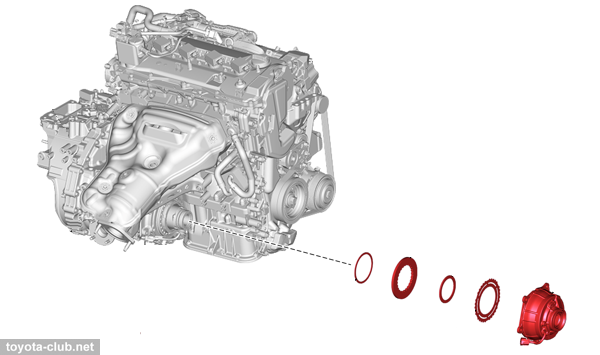
|
| T-TT-0580-19 |
04.11.2019 |
|
UA80/UB80 Transmission Side Cover Leak
|
|
2019-2020 RAV4
|
|
Leaks at the joint of the transmission 'side cover'. Status: under investigation. |
| CP-00164T-TME |
20.11.2019 |
|
RAV4 - Hybrid Battery Blower Motor Fan noise
|
|
RAV4 HV
|
|
Prescription: replace HV battery cooling fan assy (G9230-33050)
|
| T-SB-0019-20 r2 |
03.03.2020 |
|
Abnormal Buzz/Groan Noise at 20-30 mph From Front Transfer Case
|
|
2019-2020 RAV4
|
RAV4 Adventure and Limited grade AWD vehicles may exhibit an abnormal buzz/groan noise from the front transfer case at 20-30 mph when accelerating from a stop and/or at 20–13 mph on deceleration after driving the vehicle for 15–20 minutes or more. This condition occurs with Normal drive mode selected during disconnect/connect timing of the AWD system. Prescription: replace front transfer case electro-magnetic clutch assembly (04000-28142, repair kit).
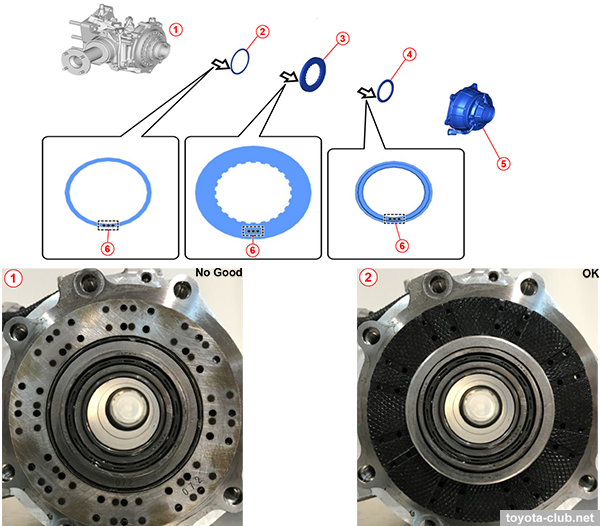
|
| BO-00230T-TME |
07.04.2020 |
|
Abnormal noise from accelerator pedal assembly (Vibration noise)
|
|
RAV4
|
|
Prescription: replace pedal position sensor assy (78110-33140 ⇒ 78110-33141)
|
| T-TT-0529-19 |
01.05.2020 |
|
HV Transaxle (Abnormal Noise/Vibration)
|
|
2019-2020 RAV4 HV
|
|
Possibility of abnormal noise/vibration from the hybrid transaxle.
|
| T-SB-0045-20 |
07.05.2020 |
|
Hybrid Warning With DTC U011087 and U029387 in Freezing Temperatures
|
|
2019-2020 RAV4 HV
|
|
Vehicles may experience a difficult-to-start condition accompanied by a hybrid system warning lamp occurring during below-freezing temperatures. This condition may occur at initial start-up after a short-distance drive. DTC U011087 and U029387
may be present, because of the IGCT relay not being able to supply power to HV ECU. Prescription: replace IGCT relay (90987-02025)
|
| #4748 |
21.05.2020 |
|
Front Lower Arm Replacement on RAV4
|
|
RAV4
|
Safety recall for vehicles produced in autumn of 2019 due to a defect of the front suspension lower arms: cracks may appear and propagate which may cause destruction of the arm and separation from the wheel (mainly if frequently operated with intense accelerations and decelerations). Prescription: replacement of the lower arms.
|
| T-TT-0559-19 |
27.05.2020 |
|
Click Noise at Approximately 20-30 mph
|
|
2019 RAV4
|
|
Adventure/Limited grade vehicles equipped with torque vectoring AWD system. Customers may experience a clicking type noise at approximately 20-30 mph with Normal or ECO drive mode selected.
|
| T-TT-0614-20 |
28.05.2020 |
|
A25A Engines - MIL ON and/or Coolant Leak from Water Pump
|
|
2020 RAV4/RAV4 HV
|
Models equipped with A25A-FKS or A25A-FXS engine may exhibit a MIL ON with DTCs P26CB71, P26CA14, P26CA31 and/or coolant leak from electric water pump body or electrical connector. Status: under investigation.
|
| 20SMD-006 |
04.06.2020 |
|
Front Lower Arm Replacement on RAV4
|
|
RAV4
|
Safety recall for vehicles produced in autumn of 2019 due to a defect of the front suspension lower arms: cracks may appear and propagate which may cause destruction of the arm and separation from the wheel (mainly if frequently operated with intense accelerations and decelerations). Prescription: replacement of the lower arms.
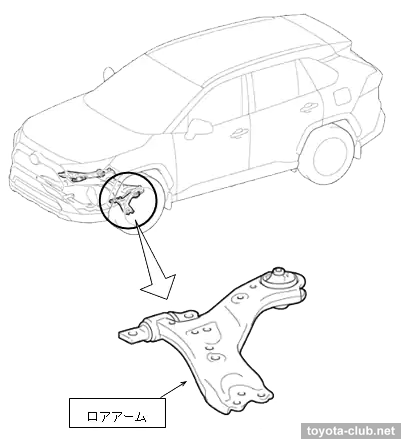
|
| T-SB-0061-20 |
16.06.2020 |
|
Electronic Power Steering (EPS) Light ON With DTC C05D604
|
|
2019-2020 RAV4/RAV4 HV |
|
Vehicles may experience a red or yellow EPS light ON condition with DTC C05D604
present when starting the vehicle or while driving. The EPS logic in the EPS gear assembly ECU has been modified to reduce the possibility of this condition.
Prescription: reprogram the EPS gear assembly
|
| BE-00214T-TME |
03.07.2020 |
|
Hybrid Ready Mode not possible (DTCs U0110, U0293) at -10 Celsius Degrees
|
|
RAV4 HV - AXAH52, AXAH54
|
|
Hybrid error messages and difficulties to go to "Ready Mode" under the following conditions: aAmbient temperatures is -10 Celsisus degrees or below. Vehicle is exposed to this temperature for several hours, typically, overnight parking outdoor.
Vehicle is driven for short period (10-15 minutes) after cold start and then, vehicle is voluntarily stopped by customer for another 15 minutes approximately.
After that, Hybrid error messages might be displayed and might be difficult or impossible to go to "Ready Mode". Multiple DTCs might be triggered, normally U0110 and U0293. After dealer proceeds to DTC Clear or after waiting time of 45-60 minutes, phenomenon disappears. Production change: material of IGCT Relay is changed to prevent icing effect and avoid subject phenomenon (90987-02025 ⇒
90987-02031)
|
| T-SB-0067-20 |
08.07.2020 |
|
Abnormal Noise From Rear Differential During Connect/Disconnect Operation
|
|
2019-2020 RAV4
|
|
DTV AWD vehicles may exhibit an abnormal noise from the rear differential assembly when accelerating from a stop and/or on deceleration after driving the vehicle for 15–20 minutes or more. This condition occurs with Normal drive mode selected during disconnect/connect timing of the AWD system. Prescription: replace differential carrier assembly (DTV) (41110-42050, 41110-42051, 41110-42052 ⇒ 41110-42053)
|
| CP-00381T-TME |
13.07.20 |
| 3 knocks in row during decelaration |
|
RAV4 AXAA54
|
|
Prescription: replace the rear differential carrier with the next modification (41110-42050/42051/42052 ⇛ 41110-42053/42080). The external symptoms of the defect are a rather wide set of noises during the cam clutch operation (buzz, groan, ratchet, grinding, bang, and, the most typical, single-double-triple clunk).
|
| CP-00426T-TME |
04.08.2020 |
|
MIL ON due to Air Fuel Ratio Sensor No 2 (DTC P013616 ,P042000)
|
|
RAV4/RAV4 HV AXAH52, AXAH54, MXAA52, MXAA54 |
|
For some vehicles produced in autumn'19 MIL turns ON at low mileage. DTCs are stored in the ECU: P013616 A/F (O2) Sensor B1S2 Circuit Current (Voltage) Below Threshold; P042000 Catalyst System Efficiency Below Threshold B1. This phenomenon caused by sensor element failure due to excessive thermal stress during supplier process.
|
| T-SB-0079-20 r1 |
14.08.2020 |
|
Outer Rear View Mirror Image Vibration While Driving
|
|
2019-2021 RAV4, RAV4 HV
|
Vehicles may exhibit a vibration/shaking of the image shown in the outer rear-view mirror(s) while driving. Mirror vibration can be observed at highway speeds of approximately 50 – 70 mph on typical concrete/asphalt road surfaces.
Prescription: remove mirror, replace mirror mounting studs, install new exterior
door reinforcement bracket, apply panel bonding adhesive, and reinstall mirror
(04000-0310R, 04000-0320R extension kit)
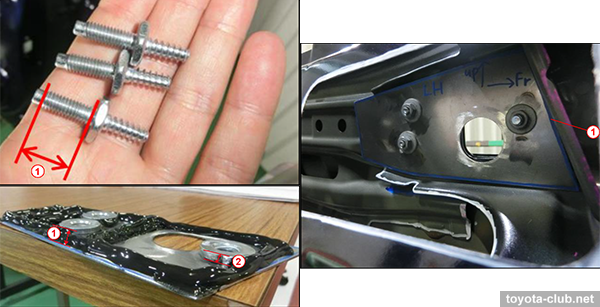
|
| T-TT-0582-19 |
19.08.2020 |
|
Squeak/groan noise from steering intermediate shaft area
|
|
2019-2020 RAV/RAV4 HV
|
Customer states that there is a squeak or groan noise from the steering column area when turning the steering wheel. Do not apply any lubricant or water to intermediate shaft or seal. This could damage the seal or lead to a repeat repair. Isolate noise using stethoscope and replace affected components.
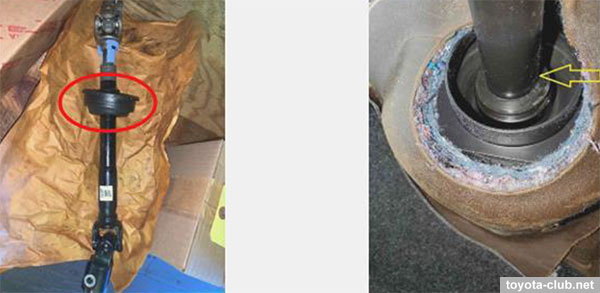
|
| BO-00440T-TME |
17.09.2020 |
|
Deck board broken and deck side trim deformed by loading in luggage area
|
|
RAV4
|
Warranty replacement of the side panel in case of its deformation with the modified one (more rigid).
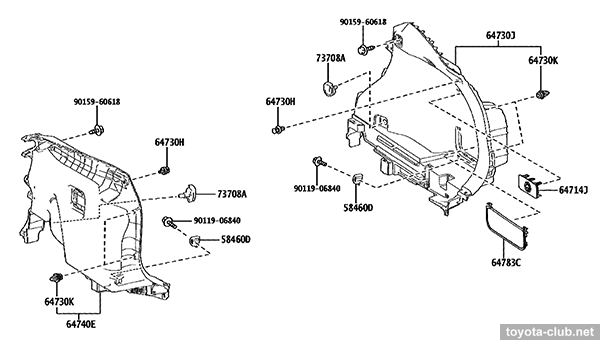
|
| T-SB-0109-20 |
29.10.2020 |
|
Vehicle Refueling Performance
|
|
2019-2021 RAV4 HV
|
|
Vehicles may experience one or both of the following conditions: the fuel gauge displays less than full when the fuel nozzle automatically clicks off; the total amount of fuel dispensed while refueling is less than expected when the fuel nozzle
automatically clicks off. Distance to empty displayed may be less than expected. Prescription: fuel sender gauge assy replacement (83320-0R050, 83320-42100 : 04000-16142), possible fuel tank repair with kit (77001-0R100, 77001-42320: 04000-15142)
|
| T-TT-0630-20 |
27.10.2020 |
|
MIL on P0AA649 / P1C8049 - Corrosion on MGR Cable
|
|
2019-2020 RAV4 HV
|
Vehicles may experience DTC P0AA649 / P1C8049 (HV Battery Voltage System Isolation Internal Electronic Failure / HV Battery Voltage System Isolation (Rear Motor Area) Internal Electronic Failure). Vehicles exhibiting this condition have been experiencing a short in MGR connector due to corrosion.
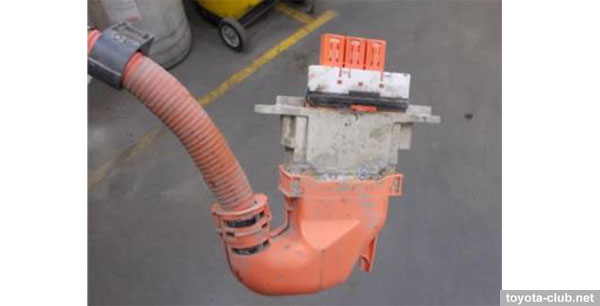
|
| G-00496T-TME |
09.12.2020 |
|
Vehicle refuelling performance - fuel gauge does not show full
|
|
RAV4 - AXAH54
|
|
Vehicles may experience one or both of the following conditions: the fuel gauge displays less than full when the fuel nozzle automatically clicks off; the total amount of fuel dispensed while refueling is less than expected when the fuel nozzle
automatically clicks off. Distance to empty displayed may be less than expected. Prescription: fuel sender gauge assy replacement (83320-0R050, 83320-42100 : 04000-16142), possible fuel tank repair with kit (77001-0R100, 77001-42320: 04000-15142)
|
| T-TT-0623-20 |
22.01.2021 |
|
Front Brake Squeal Noise
|
|
2019-2020 RAV4 / RAV4 HV |
|
Vehicles may exhibit a front brake squeal/squeak noise when braking at low speeds.
|
| T-SB-0005-21 |
27.01.2021 |
|
Inoperative Steering Wheel Controls After the IG OFF for 2 Minutes |
|
2021 RAV4 Prime
|
|
|
| T-SB-0007-21 |
03.02.2021 |
|
Hybrid Warning Message DTC P1CCC96 - Poor Ground Connection DC/DC Converter
|
|
2021 RAV4 Prime
|
Vehicles may exhibit a MIL ON condition with DTC P1CCC96 (DC/DC Converter Enable Component Internal Failure). This condition may occur from a plating issue with the DC/DC mounting bolts that cause high resistance. Prescription: replace ground bolts
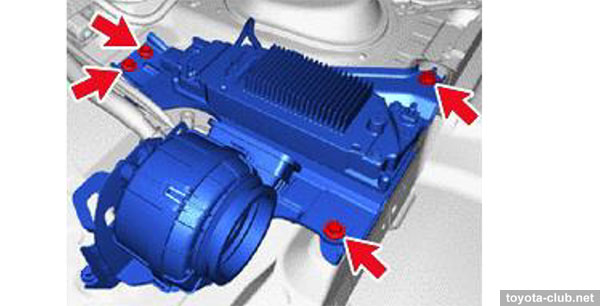
|
| T-TT-0616-20 |
22.03.2021 |
|
Steering Recalibration After Abnormal Steering Sensation or Battery Disconnect
|
|
2019-2021 RAV4 and RAV4 HV
|
|
Customers may experience an abnormal steering sensation (pulling, drifting), which may be more pronounced after a cold soak. Every time the vehicle’s battery is disconnected or discharged, the Steering Angle Neutral Point Memorization and the Steering Sensor Zero Point Calibration must be performed.
|
| T-SB-0021-21 r1 |
13.04.2021 |
|
DTC P1CE931 - No Signal From the Charging Fan
|
|
2021 RAV4 Prime
|
|
Vehicles may store DTC P1CE931 (Charger Cooler Fan Revolution Sensor No Signal),
also a longer charging period or reduced charging efficiency. The charger assembly plug-in logic has been modified to reduce the possibility of these conditions.
Prescription: reprogram charger assy plug-in
|
| T-TT-0653-21 |
26.05.2021 |
|
DTC P1AC000 - Uneven Voltage
|
|
2020-2021 RAV4 HV, Sienna HV
|
|
DTC P1AC000 in very low mileage vehicles (500 miles). Status: under investigation.
|
| T-TT-0652-21 |
28.05.2021 |
|
Abnormal Noise from Differential and Miss Match of
Connect/Disconnect Timing
|
|
2019 RAV4
|
|
DTV AWD vehicles: customers may experience an abnormal noise from rear differential after driving the vehicle for 15-20 minutes or more.
|
| BE-00571T-TME |
21.06.2021 |
|
Poor FR seat heater performance of leather seats with 3-level seat heater
|
|
RAV4 - AXAH52, AXAH54, AXAL52, AXAL54, MXAA52, MXAA54
|
|
This phenomenon is not quality problem, it is caused by specific system logic of heater control. For improve the above phenomenon, reprogram the A/C ECU to the new available calibration ID
|
| T-SB-0078-21 |
02.09.2021 |
|
Parking Brake Warning Light On With DTC C059746
|
|
2020-2021 RAV4
|
|
Vehicles may exhibit a Parking Brake Malfunction warning message with DTC C059746 (Brake System Control Module A Calibration / Parameter Memory Failure). Prescription: reprogram skid control computer
|
| T-TT-0672-21 |
29.10.2021 |
|
Oil Pan #2 Leaks
|
|
2021-2022 RAV4 HV, TMMK A25A-FKS/FXS
|
Engines may exhibit an oil leak from the oil pan #2. Status: under investigation.
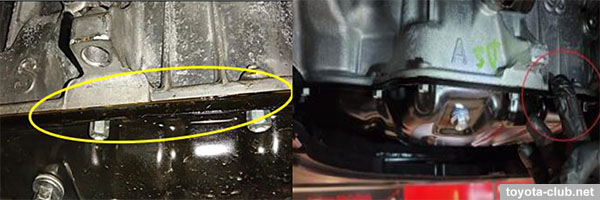
|
| TSB CP-00665T-TME |
08.12.2021 |
|
Actuator - Fix for "EPB system malfunction. Visit dealer" with DTC C059746 (sometimes C14FE14)
|
|
RAV4
|
|
Prescription: brake actuator calibration update
|
| # |
10.12.2021 |
|
| RAV4/Wildlander |
Recall campaign for chinese domestic market cars: corrosion of the EGR valve (supposedly caused by high chlorine content in the fuel), which can lead to its sticking and engine unstable operation, thereby affecting road safety. Prescription: replacement of the EGR valve with a modified one (a composite valve body instead of an all-aluminum).
|
| T-SB-0104-21 |
17.12.2021 |
|
MIL ON with Low Oil Pressure DTCs P05202A and/or
P052477 and Milky/Discolored Engine Oil in Freezing
|
| 2021-2022 RAV4 Prime, Sienna HV,
Venza HV |
Problem: engine oil emulsion (milky/discolored), 'Oil Pressure Low' message and DTCs P05202A and P052477 may appear. Cause: during short trips at freezing temperatures, abundant condensation of moisture from blow-by gases occurs, which under such conditions is not removed naturally. Prescription: ensure the emulsion did not appear as a result of coolant leak; check for DTC during warming-up to 50°C; replacement of engine oil and filter; remove all traces of emulsion residue.
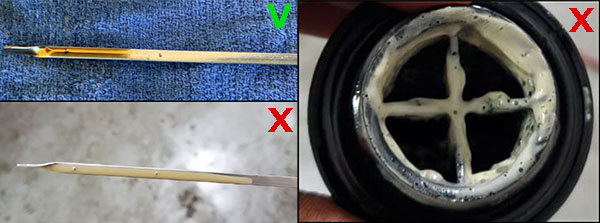
|
| TSB CP-00636T-TME |
27.12.2021 |
|
GF2A Transfer: 4WD warning light on (DTC C13F700)
|
|
RAV4
|
|
Message '4WD system malfunction' with DTC C13F700. Production change (disconnection timing logic, improved assembly process, specific spring for internal position-sensor section) implemented after 16.08.2021. Prescription - (1) transfer replacement (36100-42170,36100-42171,36100-42172 ⇒ 36100-42190), (2) 4WD control unit reprogramming.
|
| EG-00691T-TME |
02.02.2022 |
|
White smoke, Lack of power and/or engine hesitation (sometimes with DTC P319000, P04019C) due to internal damages in the EGR system (Oxidation caused by Chlorine contamination)
|
|
RAV4 - AXAA52, AXAA54, AXAH52, AXAH54, AXAL52, AXAL54, MXAA52, MXAA54 ;
|
Due to the destruction of the EGR cooler heat exchanger, coolant ingress the EGR channels and then into the cylinders. At the same time, abundant deposits (in the form of powder or crystals) form in the gas channels, often the EGR valve sticks. External symptoms - white smoke from the exhaust pipe, engine hesitation and power loss, the appearance of DTC codes (P319000, P04019C etc.), antifreeze level drops and engine overheat is possible.
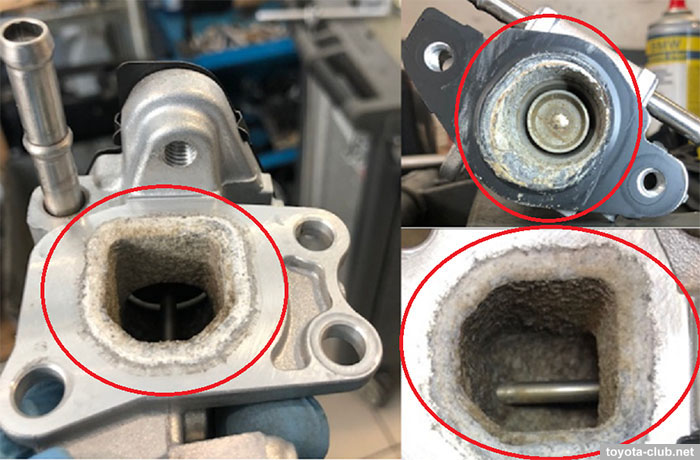
|
|

Since the moment of the presentation, it was clear that the new RAV4 turned out to be at least interesting and judging by the press almost the best popular crossover... Partly this turned out to be fair, partly - illusions dispelled over time. There are few fundamental cons: subjectively - unsuccessful organization of the driver's workspace, objectively - inadequate noisy engines, problematic 4WD in top versions, cut out safety systems on local models.
In our rankings, RAV4 has made significant progress, but still not a revolution -
there are more interesting models in this price category in terms of driver comfort; there are models with a higher level of 'quality feel'; there are models for which the concept of 'driving pleasure' applies...
However, RAV4 in any case will live long in the top of the local sales of mid-size crossovers. Someone ironically says "millions of lemmings can't be wrong" - but it is rather an echo of resentment - in itself a design for most is adequate, and what about the cost... Beati possidentes.
We continue to observe!
Related articles:
• Toyota engines. Dynamic Force - A25A, M20A
• Toyota all-wheel drive. DTV
• Toyota Direct Shift-CVT
• RAV4. Safety not for all
|
|
|